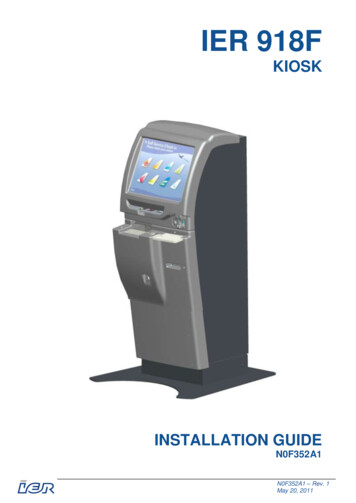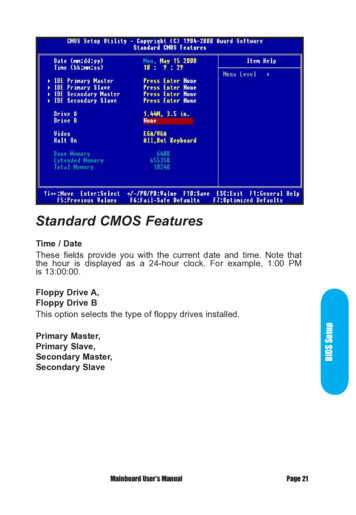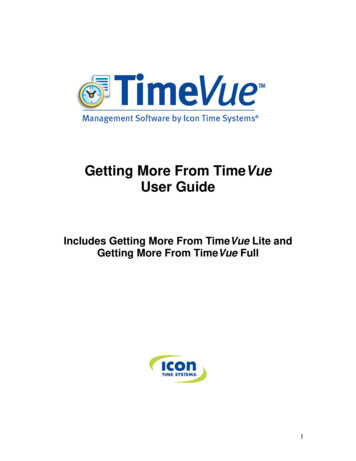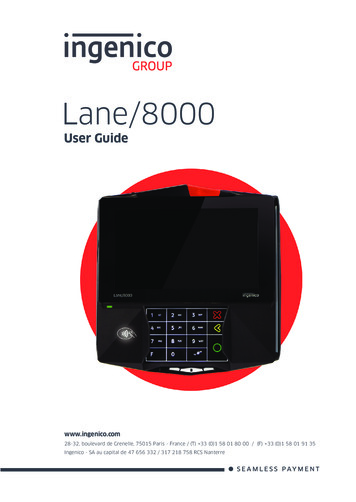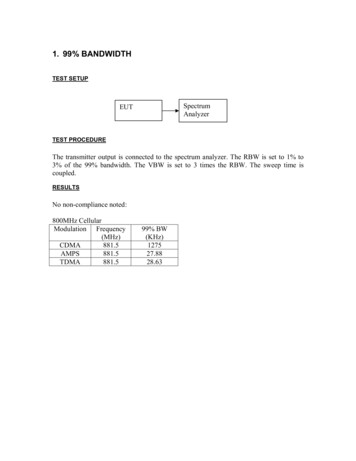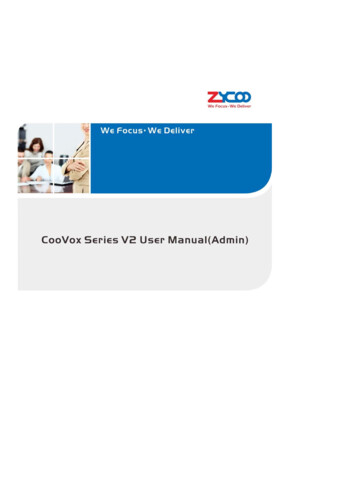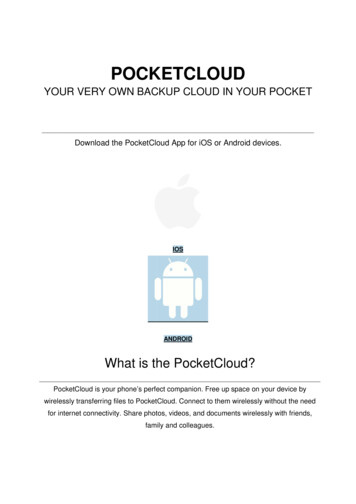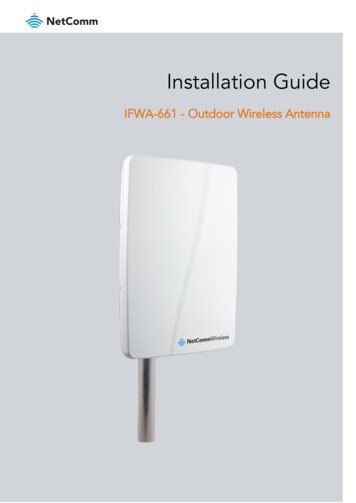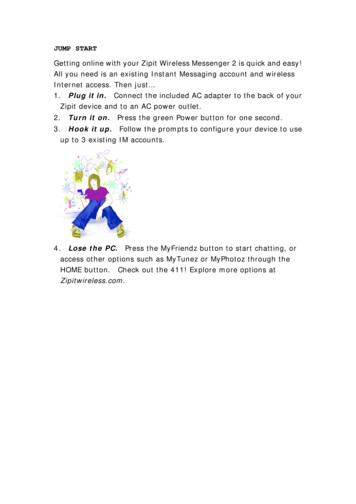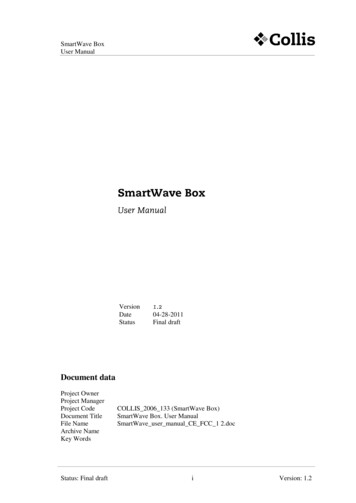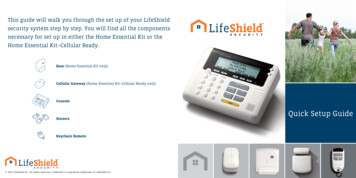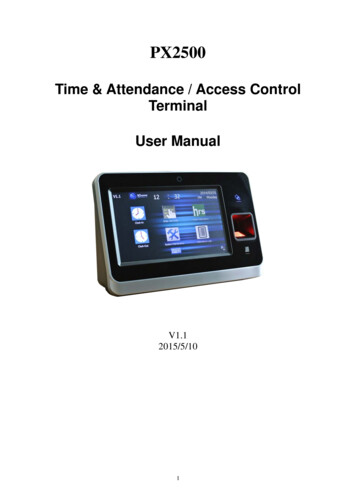
Transcription
PX2500Time & Attendance / Access ControlTerminalUser ManualV1.12015/5/101
ContentsI. Features . 3II. Specifications . 3III. Exterior . 4IV. Basic Settings . 5Clock . 5Users . 5System . 5 Network . 5 Record Option. 5 Tamper Switch . 5 Calibration . 5 Beep Hints . 5 Menu Password. 6 Security Level . 6 Volume . 6 HTTP & TCP Port. 6 FTP User Set(to be performed by professionals of your supplier only) . 6 System Maintenance . 6 Database Backup(to internal Micro SD card) — for enable/disable the function of auto databasebackup from system memory to the internal Micro SD card every day at the time that you set. 6 Language . 6 WiFi Setting . 6 Camera . 7Door . 7IO Port(DI/DO) . 7Fingerprint . 8V. User Interface. 8VI. Self-contained Time & Attendance / Access Control Software. 8Set login password . 9Database Backup(External database backup) . 9System Setting . 9Clone Database(Internal database backup) . 10System Setting - Late/Absence E-mail Notice. 10System Setting – FTP Setting . 11Attendance Report (Detailed) – for fixed shifts users . 12Attendance Report (Total) – for fixed shifts users . 12Attendance Report (Multi Work Shift) – for multiple flexible shifts users. 13Transactions . 13Transactions Delete. 13Job Code Setting . 14Set Bell Schedule . 14Slave Host Setting. 152
PC Server Info . 15Leave Setting(this function to be formally announced soon) . 15Insert Leaves(this function to be formally announced soon) . 16Work Shift Setting . 16Holiday Setting . 17Department . 17User. 17User Weekly Shift . 18VII. System Upgrade . 18VIII. Data download & upload through USB . 19I. Features ARM 800MHz CPU; communication speed 100MB.Windows CE 6.0 operating system, built-in web server, FTP server and SQL CE 3.5 database.7-inch color touchscreen LCD.Each terminal has a built-in web-based software. We also provides a free central managementsoftware (ASP.NET SQL Express) for larger-scaled application.Can use either a terminal or a PC as the server for synchronizing all the connected slave terminals.TCP/IP interfaced. LAN / WAN(WiFi supported).1.3MP camera records each punching to avoid faking.Every user can check its own attendance logs & work hrs between each IN & OUT record directlyon the Touchscreen.Auto reconciliation of user & fingerprint accounts among multiple terminals in network.256MB DRAM 512MB Flash 2GB Micro SD.Optical fingerprint reader 125KHz Mifare 13.56MHz card reader.Color touchscreen wallpaper is replaceable for displaying custom graphic design & company logo.Can store 9,500 fingerprints(2 fingerprints each user), 30,000 cards and 250,000 events.50 programmable bell ring times (through web browser). Music ring file(.wav) is changeable via FTP.II. SpecificationsCPU:Memory:Display:Fingerprint sensor:Card reader:Camera:Communications:Power input:Input:Output:Sound output:LED indicator:Operating temp.:Operating hum.:Measurements:Weight:ARM 800MHz256MB DRAM 512MB Flash 2GB Micro SD7 inch 800x480 touchscreen LCDScratch-proof OpticalEM & Mifare1.3MP*1RJ45*1, WiFi*1, USB2.0*1DC12V 1.25 2ASensor*2(Push Button, Door Sensor)Relay*2(Door Lock, Alarm or Bell) & Wiegand*1Piezo Buzzer & 3020 speakerComm. & card/finger reading0 50 C / 32 122 F20 95%(non-condensing)226*150*72 mm1200 g3
III. Exterior4
IV. Basic SettingsClick[System Maintenance] to enter the setting menu(necessary settings aremarked in Blue):ClockManual time: Select Time Zone(UTC) Click Apply Set Date & Time.Auto time: Tick the Auto Time check box fill out IP address of a preferred time server click Apply.UsersAdd/Delete/Modify user information including User ID, Card numbers(Card numbers are usedfor identifying users and their enrolled fingerprints. It can be the number of an actual RF card, oryou may make up a number for an user who is requested to use fingerprint only.), User Names,Access PIN(default: 888888), User Group(if set as VIP the user will be allowed toon the bottom of PX2500’s main screen to pop up the keyboard and enter itsclick the keyboard iconcard number to open the door without reading its card or fingerprint), & User Validity. A muchfaster and more convenient way for User management is through your PX2500’s Self-containedor PC-end web-interfaced software (for details please refer to p.8 & 15).System NetworkFor setting IP address, Sub-net Mask, Gateway & DHCP on/off while usingEthernet cable. Once completed click [Apply] to save settings. Record OptionFor selecting required records & relevant rules:In Record — In / Clock In records of registered users.Out Record — Out / Clock Out records of registered users.Event Record — including all records other than the above two, such as records of unregistered users,alarm, open-button, door open from software, etc.Record Cycle — if enabled, new records will overwrite old records when PX2500 memory is full.Unduplicate — once enabled PX2500 will stop recording the same card or fingerprint reading in the setinterval(inMinute).5 Digit — this is a special feature designed for those who require the card reader to decode only 5 digits ofa card number. Ignore this if you are not sure about what this is! Tamper SwitchIf enabled, PX2500 will alarm in case of vicious destruction. CalibrationUsed for re-calibrating touch screen if touch point found imprecise. Steps to do:1. Click [Re-calibrate].2. A positioning cross will appear sequentially 5 times. Press on the centers of these crosses using yourfinger tip or a stylus precisely until you finish all the 5 crosses. Double-click on the blank screen to completethe procedure. Beep Hints5
For enable/disable sound for the following:1. Key2. Music Ring3. Hints Menu PasswordFor setting a password for entering [System Maintenance]. Steps to do:1. Old PIN: input old password(leave it blank if there is not).2. New PIN: enter a new password(max. 6 digits).3. New PIN Again: enter the new password again.4. Click [Apply] to save setting. Security LevelFor adjusting strictness of fingerprint verification. There are totally 5 levels. The higher the figure is thestricter the verification will be(level 1 is recommended). VolumeFor adjusting the speaker volume(totally 6 scales & the Mute option). HTTP & TCP PortFor assigning PX2500 HTTP & TCP port. FTP User Set(to be performed by professionals of your supplier only)Each on-line(LAN or WAN) PX2500 can be logged in via FTP for updating or maintaining its:1. Residence Application(firmware).2. Datebase(SQL CE3.5).3. Self-contained Time & Attendance / Access Control software.4. Sound files(.wav).5. All graphics used as User Interfaces, such as the touch screen wallpaper. System Maintenance1. Initialize System: Delete “everything”, including all user information, users’ enrolled fingerprints,attendance records & reset to factory defaults.2. Delete Users & Finger: Delete all users & their enrolled fingerprints but keep all other settings.3. Delete All Fingerprints: Delete all enrolled fingerprints but keep all users and other settings.4. Delete Transactions: Delete all attendance & event records.5. Reboot Device: for rebooting PX2500.6. Database & Fingerprints restore: Your terminal system can back up database & enrolled fingerprints tothe internal Micro SD card every day at the time that you have preset so that in case of data getting lostdue to any hardware issue you will be able to restore the database and fingerprints copy on therepaired or a spare terminal.7. Restore from Server: Your terminal system can back up database & enrolled fingerprints to a designatedFTP directory every day at the time that you have preset so that in case of data getting lost due to anyhardware issue you will be able to restore the database and fingerprints copy on the repaired or aspare terminal. For detail of how to set the FTP data backup please refer to [System Setting] in page12. Database Backup(to internal Micro SD card) — for enable/disable the function of auto database backupfrom system memory to the internal Micro SD card every day at the time that you set. LanguageFor selecting interface language of PX2500’s touch display. Currently supports English & Chinese. Morelanguages will be included soon. WiFi Setting6
For those who use wireless LAN for data communication.1. Select Encryption mode.2. Select Authentication mode.3. Provide you Wireless LAN connection password/key. CameraProvides following settings to the built-in camera:1. Enable/Disable camera function.2. Face detection enabled: once this function is enabled the camera will not take a snap until it successfullydetects a human face3. Photo storage path: for changing photo storage directory in PX2500’s memory(if changed you will not be ableto browse photos linked to each attendance/access log in Transaction Report of PX2500 self-contained TimeAttendance/Access Control software).Door Contr Mode — this function currently does not apply to model PX2500. Entry Type(authentication) — provides 6 different combinations of user identification:1. Card only.2. PIN only(default PIN: 888888. Changeable at [Users]).3. Card & PIN.4. FP only(fingerprint only).5. FP & Card.6. FP or Card(either of two will be accepted). Sensor Type: Type of sensors connected to PX2500(Normally Open/Normally Close). Button Type: Door-open button type(Normally Open/Normally Close). First Card Open: This is a special feature that once activated, in the access-allowed periods ofstselected [User Group], the door will be kept unlocked since the 1 reading of a registeredcard/fingerprint until the period ends(door auto lock up then). This function currently doesnot apply to PX2500. Open Time: Door unlock duration after each reading of a registered card/fingerprint(default: 5 seconds). Close Time: the interval from the door being unlocked until the door sensor starting detecting whether thedoor is closed properly(default: 30 seconds). PX2500 will alert if the door detected not closed. Access PIN: for setting a common(applies to all registered users) door-open password(referring to [EntryType] described in p.6).IO Port(DI/DO) Relay 1: for assigning for connecting a Lock, Bell, Alarm, Illegal or Null. Relay 2: for assigning for connecting a Lock, Bell, Alarm, Illegal or Null. WG In: if a Wiegand-interfaced card reader is applied as an external reader you may define itas for In or Out here. Card(main): for assigning PX2500’s built-in card readers(both125KHz & 13.56MHz) as forIn or Out. This setting will be necessary only when a Wiegand-interfaced external card readeris applied to PX2500 for reading cards on different card readers at either side of a door.7
FP(main): for assigning PX2500’s built-in fingerprint reader as for In or Out. WG Out: for connecting PX2500 to other host controller(PX2500 simply works as a datacollection unit).FingerprintFor enrolling fingerprints of registered users. Each registered user is allowed to enroll 2different fingerprints. Steps to do:1. Input the user’s Card Number.2. Click[Enroll Fingerprint] or [Delete Fingerprint].3. When [Enroll Fingerprint] is clicked, red backlight of the fingerprint sensor on put your finger on redbacklight off take your finger off scanner red backlight on again put finger on again red backlightstndoff again 1 fingerprint enrollment completed repeat the same procedure for enrolling the 2fingerprint if necessary.V. User InterfaceClick this icon & read a card or fingerprint for a Clock-In.Click this icon & read a card or fingerprint for a Clock-Out.For entering a Job Code(0 255) before reading a card or fingerprint. The entered Job Code will bepart of the attendance record and used for distinguishing/classifying attendances of different types of works.Enter a Job Code, clickand then read a card or fingerprint.Click this icon to enter the [Check Attendance] page. After reading your card or fingerprint you willget your own attendance hours between each Clock-In & Clock-Out. You may choose to browse data ofToday, A Week, A Month, Select a Date or All. Click the [Exit] button to return to the main screen after aquery.Click this icon to enter the [Attendance Logs] page. After reading your card or fingerprint you will beable to browse your own Clock-In & Clock-Out records. You may choose to browse data of Today, A Week, AMonth, Select a Date or All. Click the [Exit] button to return to the main screen after a query.VI. Self-contained Time & Attendance / Access Control SoftwarePX2500’s unique Built-in Web-based software is designed for fulfilling easy Time & Attendance management of small8
businesses(especially for stand-alone usage and employee numbers is under 30). It allows a system manager tomanipulate it simply through a Web Browser such as Microsoft Internet Explorer! Please setup the system accordinglyfollowing below steps:Log onto an PX2500’s built-in web application.Method 1:Connect your PX2500 clock to Ethernet and the device will get an IP address for itself. Enter Menu on the colortouch-screen System NetWork and write down the device IP address you see. Go to any computer which is in thesame network with your PX2500 terminal, open web browser(ex. Microsoft Internet Explorer) and enter IP addressfollowing http:// and followed by “/login.asp”(ie. http://192.168.123.105/login.asp) and press [Enter] key to enter thesystem log-on page. Enter the default user “ADMIN”, leave the password blank, and click [Login] to enter the mainpage.Method 2(for setting a designate IP address):Enter Menu on the color touch-screen System and complete IP address, Subnet Mask, Gateway settings accordinglyand disable DHCP. Connect your PX2500 clock to Ethernet(LAN), go to any computer which is in the same networkwith your PX2500 terminal, open web browser(ex. Microsoft Internet Explorer) and enter IP address following “http://“and followed by “/login.asp”(ie. http://192.168.123.105/login.asp) and press [Enter] key to enter the system log-onpage. Enter the default password “admin” and click [Login] to enter the main page.Remark: For WiFi version the settings are at Menu System WIFI SET and Menu System WIFI IPLogin pageMain pageSet login passwordFor changing the default web login password.1. Click on [Admin Password] in the left menu to enter the setting page.2. Enter the new password and click [Save] to confirm the change.Database Backup(External database backup)For copying your PX2500 database to your computer.1. Click on [Database Backup] in the left menu.2. PX2500 database consists of two files, KATS.SDF & DISTR.SDF. Simply click on each file to download it to afavorite directory in your computer so that they can be applied in case of a hardware issue with your PX2500/SW.System SettingClick on [System Setting] in the left menu and you will find 3 settings:1. Select the Date format that you want to apply to all attendance reports.9
2.3.Enable or disable the Leave Setting function(this function is not ready yet. It’s to be formally announced soon).Set the storage roof of Default Database(currently used by system) to maintain high system efficiency.Soft Limit: system will emit a reminder when records accumulate to the soft limit.Hard Limit: system will force user to run [Transactions Delete] when records accumulate to the hard limit.Clone Database(Internal database backup)Backup database in PX2500’s own memory(Micro SD card). [Clone Database] can be taken any time you feelnecessary or every time before you run [Transactions Delete]. You may also switch to use an older Clone Database forbrowsing earlier data or generating earlier attendance reports any time.System Setting - Late/Absence E-mail NoticeE-mailing system administrator an employee Late/Absence report after 30 minutes since assigned work shifts startevery day.1. Make sure you have assigned a valid e-mail account for the system supervisor:2. Click to enter [System Setting] [Late/Absence e-mail notice] enable Daily Transaction10
Notification(Late/Absence) fill in Subject click SAVE. Your terminal will auto reboot once SAVE button isclicked.3. Click to enter [System Setting] [SMTP Setting] fill in necessary information referring to below example Click SAVE button.System Setting – FTP SettingYour terminal system can back up database & enrolled fingerprints to a designated FTP directory every day at the timethat you have preset so that in case of data getting lost due to any hardware issue you will be able to restore the databaseand fingerprints copy on the repaired or a spare terminal.Click to enter [System Setting] fill in necessary information referring to below screen click SAVE.11
Attendance Report (Detailed) – for fixed shifts usersFor generating detailed employee attendance reports.1. Click on [Attendance Report Detailed] in the left menu.2. Select a searching criterion(by User, Department or All employee).3. Set the query timeframe(yyyy/mm/dd yyyy/mm/dd). Leave the timeframe blank for searching all time.4. Click the [Query] button to generate the report. You may also click [Print] to print the report or export the reportin .csv, .txt and .xls.Attendance Report (Total) – for fixed shifts usersFor generating attendance summary(accumulated worked hours).1. Click [Attendance Report Total] in the left menu.2. Select searching criterion(by User, Department or All employee).3. Set the query timeframe(yyyy/mm/dd yyyy/mm/dd). Leave the timeframe blank for searching all time.4. Click the [Query] button to generate the report. You may also click [Print] to print the report or export the reportin .csv, .txt and .xls.12
.Attendance Report (Multi Work Shift) – for multiple flexible shifts usersThis function is for calculating work hour sum of employees who are requested to attend more than one flexible shifts aday. Work hour sum can be calculated and displayed by each single shift, each day or selected date range. To apply thisfunction the clock(PX2500 series) needs to be switch from Access Control to Time & Attendance mode and employeesare requested to press 1 for a clock-in and 2 for a clock-out before they scan their fingerprints or read their proximitybadges.1. Click [Attendance Report (Multi Work Shift)] in the left menu.2. Select users(by User, Department or All employee).3. Set the query date range(yyyy/mm/dd yyyy/mm/dd). Leave the columns blank for searching all time.4. Select report type(by work shift, daily sum or sum of selected date range).5. Click the [Query] button to generate the report.TransactionsFor browsing or exporting attendance records.1. Click [Transactions] in the left menu.2. Click [Add New] directly to generate a new record manually select a Card ID(Employee) enter date & time forthat record(format: yyyy/mm/dd hh:mm:ss) click [Save] to confirm or [Cancel] to abort.3. Set searching criteria and click [Search] to browse current records stored in the clock database.4. Click the [Query] button to generate the report. You may also click [Print] to print the report or export the reportin .csv, .txt and .xls.Transactions DeleteFor deleting Transactions(access/attendance records) to reduce database size. You have following choices:1. Delete all records but keep those of latest 2 6 months.13
2.3.4.Delete all records in the selected date range.Delete all records .Enable/disable internal database auto backup every time you perform data deletion.Job Code SettingFor defining reasons of punches(only valid in Time Attendance mode under which each user may enter a code from 1 9before scanning a card or fingerprint).1. Click [Job Code Setting] in the left menu.2. Click ADD NEW to enter the setting page.3. Enter a Job Code and its status definition and click Save.Set Bell ScheduleFor programming 50 sets of bell activation schedule.1. Click on [Bell Schedule] in the left menu to enter the bell schedule list.2. Click on the [Bell Schedule No.] to enter the setting page.3. Tick the [Enabled] check box, fill out the [Ring Time] and [Duration], and set the [Weekly Schedule].4. Click [Save] to confirm change or [Cancel] to abort.14
Slave Host SettingIf you have multiple PX2500 terminals in a network, you are allowed to designate one of them as a Master terminal. Allthe users and fingerprints registered to the Master terminal will be reconciled to all the Slave terminals and all theclock-In & Clock-Out records on the Slaves will be collected to the Master in real time.1. Click on [Slave Host Setting] in the left menu to enter the Slave terminal list.2. Click on a Slave terminal ID(1 30) to enter the detailed setting form.3. Enable the Slave terminal, enter the IP address it applies and give the terminal a name.4. Click [Save] to confirm or [Cancel] to discard.Notice: This setting is only required on the unit that you want to make as Master/Server.PC Server InfoFor editing server information if you choose to install Kizone’s KATES central management software on a PC tomanage all the PX2500 in the network (this function is to be set up by professional from your product supplier).1. Enter the IP of the server PC.2. Keep the server port 9008 unchanged.3. Tick to enable this setting.4. Give this PX2500 an ID.5. Click [SAVE].Leave Setting(this function to be formally announced soon)For appending different types of leaves.1. Click[ADD NEW].2. Enter Leave No/ID and Leave Name and click [SAVE].15
Insert Leaves(this function to be formally announced soon)For inserting leaves for users/employees. You are allowed to insert 3 leaves a day at most.1. Click [ADD NEW].2. Select user/employee, date, leave, enter hours and note and click [SAVE].Work Shift SettingFor generating employee work shifts.1. Click on [Work Shift Setting] in the left menu to enter the work shift list.2. Click on an existing shift code to modify the details or click [Add New] to append a new work shift.3. Enter Shift Code, Shift Name, Start Time, End Time and Auto Deduct Break time. Tick the Default Work Shift checkbox if necessary.4. Click [save] to confirm, [Cancel] to abort or [Delete] to delete an existing work shift.Notice: A Cross-day shift spanning two days is allowed only when it’s followed by another Cross-day shift or a Holiday.16
Holiday SettingFor appending holidays in the year.1. Click [ADD NEW].2. Select Date and enter description(holiday name) and click [SAVE].DepartmentFor browsing, modifying and generating departments.1. Click [Department] in the left menu to browse the current departments list.2. Click the Department ID directly to get the detail enter a new Department ID click [save] to confirm or [Cancel]to abort.3. Click [Add New] enter Department ID enter Department Name click [save] to confirm or [Cancel] to abort.UserFor browsing/modifying/deleting/adding users(employees).1. Click [User] in the left menu to browse current users.2. Click on User ID directly for modifying details of or deleting the user.3. Click [Add New] to enroll a new user. Enter User ID enter User Name assign a department for the user enter theCard No. if a proximity card will be used(for those users who are using Fingerprints only please also enter virtual CardNo. ie. 0001, 0002, 0003, etc.) click [save] to confirm or [Cancel] to abort.Notice: All enrolled users will have door access right if PX2500 is applied for door control.17
User Weekly ShiftFor programming weekly shift schedules for each user.1. Click [User Weekly Shift] in the left menu.2. Select an user select an work shift for each week day and weekend c
3.When [Enroll Fingerprint] is clicked, red backlight of the fingerprint sensor on put your finger on red backlight off take your finger off scanner red backlight on again put finger on again red backlight off again 1. st. fingerprint enrollment completed repeat the same procedure for enrolling the 2. nd. fingerprint if necessary.
